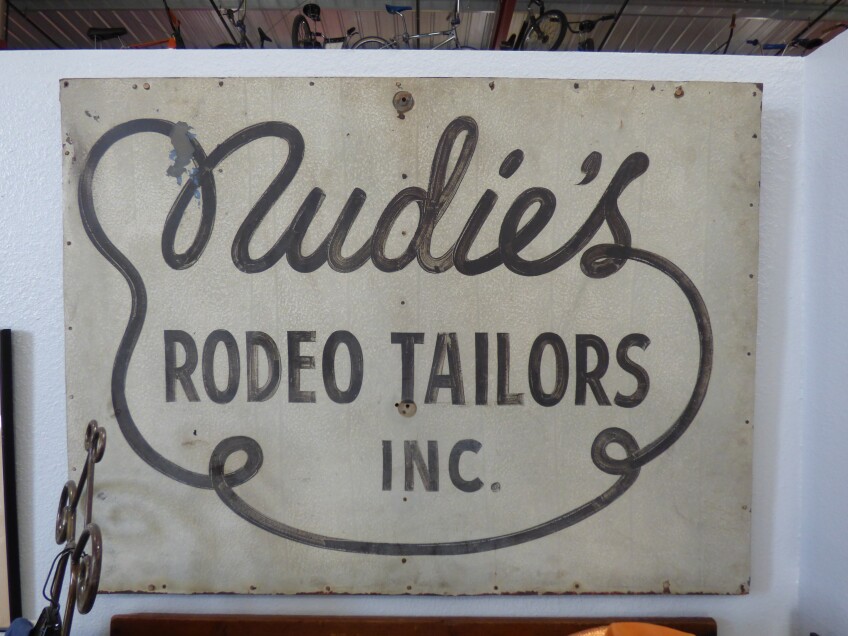Giddying-up in Glitz: The Blinged-Out Western Wear of Nathan Turk and Nudie Cohn
Western wear is America's folk costume. It represents our heritage the way lederhosen does to German
- Fashion Designer Michelle Freedman, co-author, "How The West Was Worn"
At the Autry Museum of the American West in Griffith Park, there are thousands of practical artifacts of the Wild West — scratched tin cups, banged up chuckwagons, worn leather saddles. But enter a certain room and, suddenly, there is glamour. Bedazzled western costumes, shining with rhinestones, rich in intricate embroidery — made for the camera, the crowds and the stage — shimmer in the museum’s dark interior.

These costumes, worn originally by family-friendly singing cowboys and girls like Tex Ritter and Roy and Dale Rogers, would eventually be coveted by psychedelic rock stars and country superstars including John Lennon, Robert Plant, Gram Parsons, Elvis, Mick Jagger, Cher, Tammy Wynette, Dolly Parton and even The Grateful Dead. Designed mostly by first-generation immigrants to America, the rhinestone cowboy aesthetic would come to symbolize the best of the Wild West dream — big, bold, brawny and bedazzled.
Early country-western entertainers and movie stars had long been influenced by the decorative clothing worn by rodeo cowboys and performers. “The celluloid cowboys like Tom Mix originally influenced decorative Western wear,” explains music and western historian and best-selling author Holly George-Warren, co-author of the definitive “How the West Was Worn.” “Mix reportedly embroidered flowers himself on his bib-front Western shirts. Gene Autry and Roy Rogers began wearing shirts with beautiful embroidered motifs; early on, they went to Ben the Rodeo Tailor, who opened a shop in Philadelphia in 1930 and made outfits for rodeo and trick riders.”
See how singing cowboys captivated the imaginations of Americans on Ken Burns' "Country Music."
Rodeo Ben, whose given name was Bernard Lichtenstein, soon had a West Coast counterpart — a fellow Eastern European immigrant named Nathan Turk. “He was born in Poland in 1895 and immigrated to America after apprenticing with a tailor in Warsaw,” explains George-Warren. “He opened a shop in Van Nuys in 1923, on Ventura Boulevard. He first made jodhpurs for clients like actor Paul Muni and by the late ‘30s was making custom Western designs for Gene Autry and other singing cowboys. He incorporated Eastern European Slavic folkloric embroidery motifs into his Western-wear designs.”
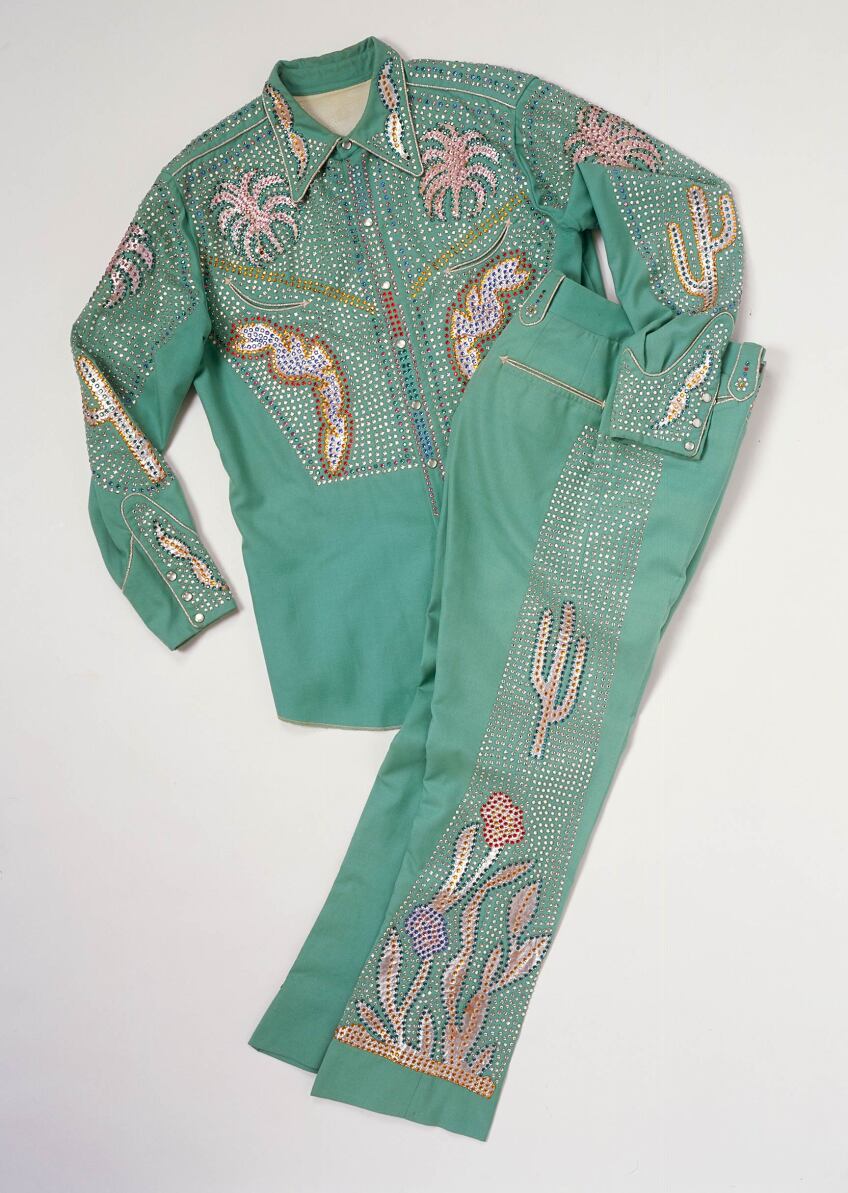
From his shop in Van Nuys — the heart of Hollywood’s cowboy country — Turk, who according to George-Warren was “a very friendly and soft-spoken man who was dedicated to his craft,” dressed the biggest cowboy stars of the time. While Turk’s bespoke shop was a steady success, it would take a true showman to shoot cowboy clothing into the cosmic stratosphere.
That man was born Nuta Kotlyarenko in Kiev in 1902. Trained as a tailor in Ukraine, legend has it that Kotlyarenko was obsessed with silent Western movies and that he would watch them at the cinema whenever he had the chance. Renamed Nudie Cohn by U.S. immigration officials who didn’t bother to learn his name, Cohn eventually became a tailor in New York City, making custom bedazzled costumes for burlesque dancers.
Eventually, Cohn and his wife, Bobbie, made their way to Los Angeles and began to create costumes for the country-western stars kicking around the Valley. In 1947, he opened his first shop in North Hollywood, which quickly became not just a tailor shop but a hangout for the stars he clothed in increasingly outrageous designs.
“Nudie originated putting rhinestones on Western clothing,” George-Warren says. “His first client to get rhinestones on a shirt was honky-tonk singer Lefty Frizzell.” These rhinestones, which Cohn had become adept at using during his burlesque days, would quickly become his trademark, imitated and admired the world over. “My impression of an entertainer is, he should wear a flashy outfit to be fair to the public,” Cohn told Rolling Stone in 1969. “He shouldn't be wearing a sport coat like the people in the audience. The costume is the first impression, and it should be flashy.”
The two men —brash and bold Cohn and humble Turk — would be locked in a friendly rivalry for decades. “Turk and Nudie competed for big-ticket celebrity clients, many of whom frequented both shops,” George-Warren says. But while Turk stuck to what he did best — tailoring — Cohn became a pioneering branding expert and a celebrity in his own right.
“Nudie socialized more with his clients like Roy Rogers & Dale Evans and was more of a self-promoter, driving around Hollywood in his over-the-top ’Nudie Mobile’ — a white Cadillac convertible outfitted with steer horns and an interior covered in silver dollars,” George-Warren says. “It worked — we now call these spectacular rhinestone-studded embroidered outfits still being created today by custom designers like Jerry Lee Atwood (for Post Malone and Lil Nas X) ‘Nudie suits.’”
Rough and tumble honky-tonk stars from Bakersfield like Rose Maddox and Bonnie and Buck Owens were early adopters of the brash look. The costumes Cohn and Turk created were uniquely Californian, borrowing not only from their Eastern European heritage but also from Native American and Mexican traditions. “Owens and his band the Buckaroos wore fabulous suits custom made by Turk and Nudie,” George-Warren says. “Their style was influenced by the mariachi look from Mexico and their suits were later made by Mexican-American custom tailors Manuel (Cuevas) and Jaime (Castaneda), both of whom started their careers working with Nudie.”

By the 1950s and ‘60s, the rhinestone cowboy look was spreading across the country — all the way to Music Row in Nashville, Tennessee. “The fancy Western wear look became popular in California first, where artists wore embroidered shirts in films and fancy suits onstage,” George-Warren says, and “then spread to Nashville, where musicians wore them on the Grand Ole Opry.”
For many hardscrabble country-western and soul stars, these elaborate, expensive costumes (Cohn made a gold lamé suit for Elvis costing $10,000) signaled that they had achieved the fabled “American Dream.”
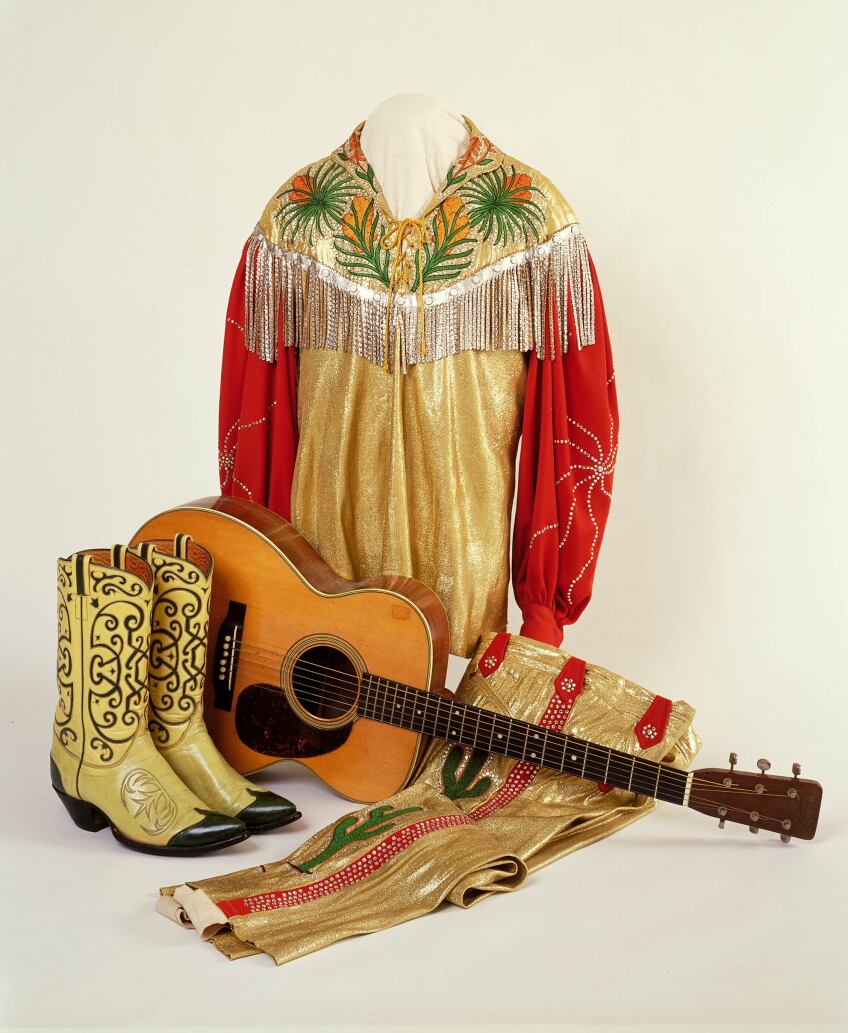


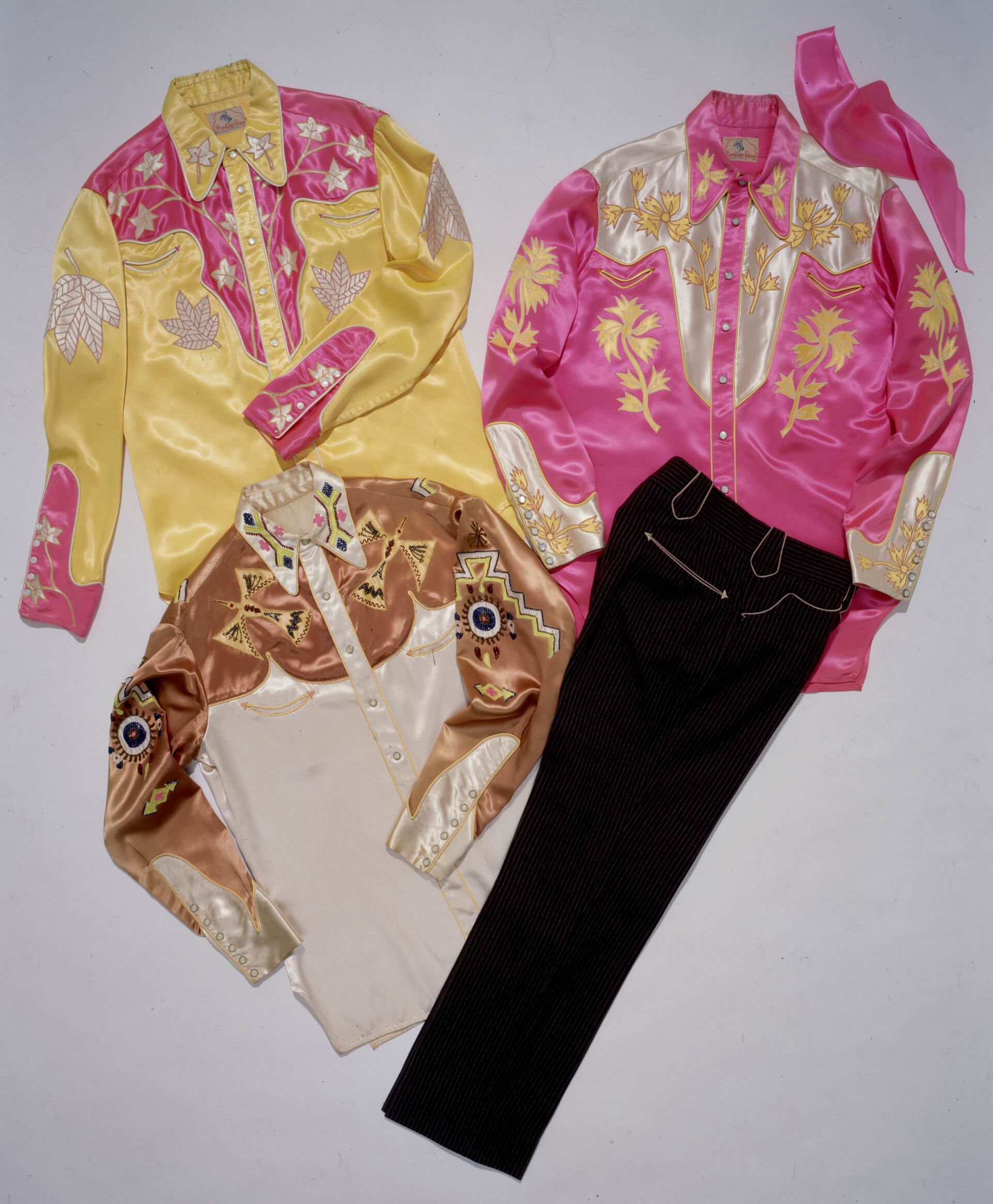
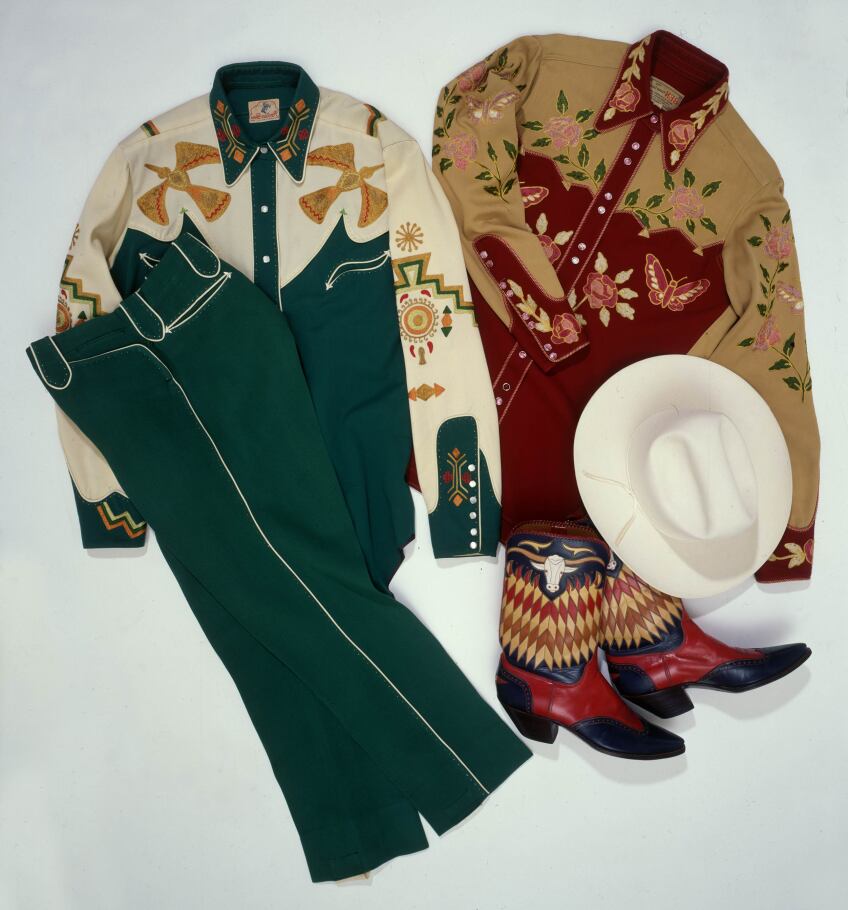

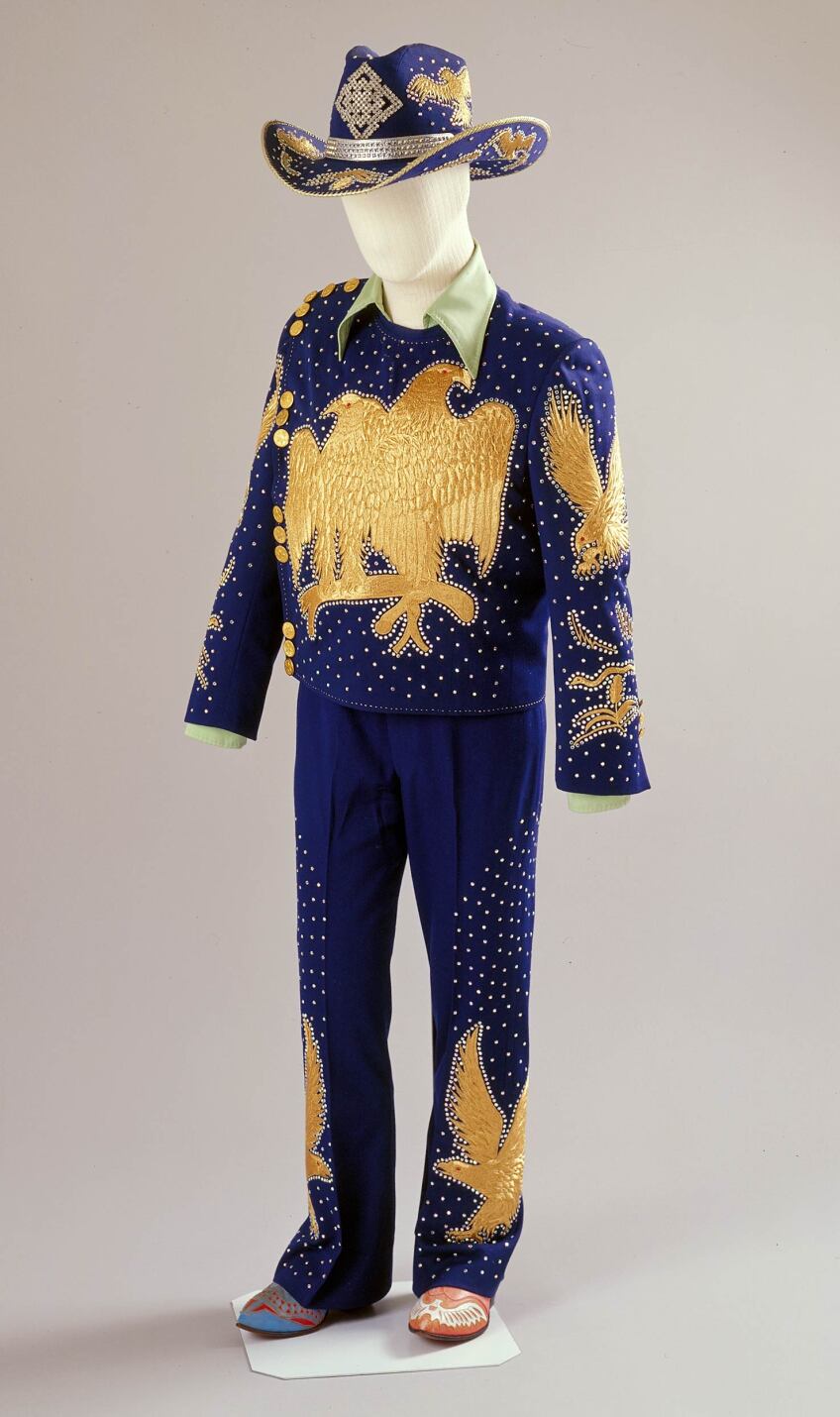



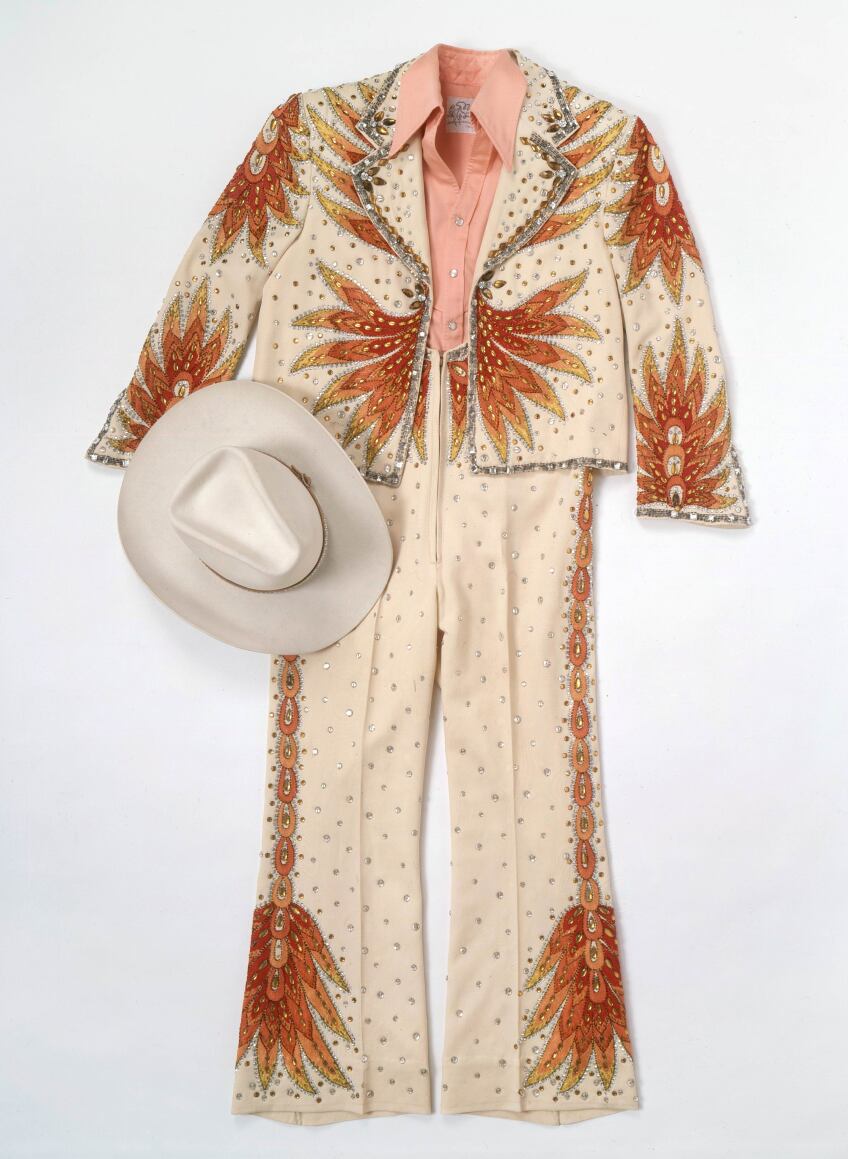

“They wanted to stand out on stage and screen and make an indelible impression on their audiences,” George-Warren explains. “Many of these entertainers came from impoverished backgrounds and these clothes sparkling with rhinestones turned them into our own American ‘royals.’”
The ploy worked. According to George-Warren:
Audiences loved these flashy outfits and the stars developed signature looks. Some C&W singers had their own special embroidery — for example, Gene Autry often had thunderbirds embroidered on his shirts. Later Nudie created “music video suits" where the embroidery designs would actually illustrate lyrics of a hit song, like "In the Jailhouse Now" for Webb Pierce and "May the Bird of Paradise Fly Up Your Nose" for Little Jimmy Dickens. Other entertainers had embroidery that referenced their name: Pee Wee King had crowns and castles embroidered on his suits; Porter Wagoner had wagon wheels. Roy Rogers had his famous dog Bullet embroidered on a shirt.
During the mid-20th century, Cohn and Turk were not the only costuming innovators on the country-western scene. Marge Riley and Fay Ward had been rodeo riders before becoming designers themselves. There was Nudie’s master embroiderer Rose Clements, who was originally from England. Then there was Viola Gray, a genius embroiderer and designer who opened her own shop, as well as working for the cowboy star turned entrepreneur Rex Bell. According to the designer Manuel, Gray was “a lovely little blond woman, full of energy, piss and vinegar who ran her shop with an iron fist.”
And there is Mexican-born Manuel Cuevas himself, known as the “rhinestone Rembrandt.” During his long career, Manuel (Cohn’s former son-in-law) has created outrageous, colorful costumes for The Beatles, Robert Redford (The Electric Cowboy), Emmylou Harris, Wynonna Judd, and John Travolta (Urban Cowboy).
By the 1960s and ‘70s, these couture creations — Nudie Cohn’s and Manuel’s in particular — had become the height of hip, counterculture cool. Cohn was so cool he was the cover-boy on a 1969 edition of Rolling Stone:
“My costumes used to be called corny,” Nudie says, adjusting a gold pinkie ring shaped like a saddle and studded with diamonds. “Now they call us mod. I don't care. Country music has took over rock and roll. Doesn't matter to me who buys clothes. Whatever does the best.”

Get a feel for Nudie's style inside this 360-degree video of their family car.
Cohn and his creations would be further immortalized in his customer and friend (and frequent jam partner — Cohn played mandolin) Glen Campbell’s iconic 1975 hit song “Rhinestone Cowboy.” Today, the “look” is still copied by everyone from Kacey Musgraves to Keith Urban to Jenny Lewis. Though Nudie, Turk and Rodeo Ben have now all passed on, their original outfits continue to be hot commodities for collectors, and it’s not surprising why.
“The workmanship and the tailoring are exquisite,” George-Warren says of these now historical pieces, “and of course the fanciful embroidery is so detailed and spectacular to examine up-close. The rhinestones still sparkle like the day they were hand-studded onto the garments!”
The Valley Relics museum holds many artifacts from Nudie's. Get a peek in this slideshow.
